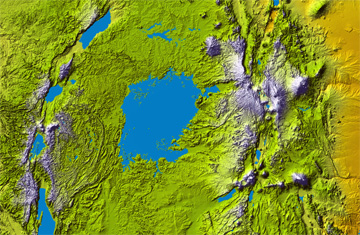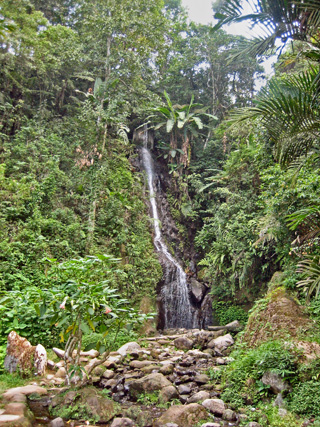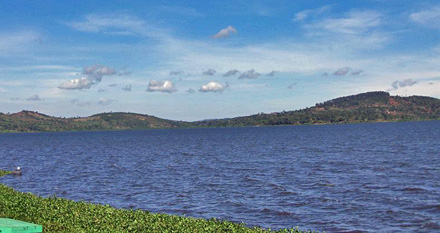Navigation
Lake Victoria Communities Could Be Key to Millions of Global ‘Climate’ Change Dollars for Poor around the World
Village communities in western Kenya, alongside ones in Niger, Nigeria and China, could become the key to unlocking the multi-billion dollar carbon markets for millions of farmers, foresters and conservationists across the developing world.
 |
| Topography of Lake Victoria. Image catalogued by Jet Propulsion Lab of the United States National Aeronautics and Space Administration (NASA). |
Village communities in western Kenya, alongside ones in Niger, Nigeria and China, could become the key to unlocking the multi-billion dollar carbon markets for millions of farmers, foresters and conservationists across the developing world.
Catchments in and around Lake Victoria have been chosen as a test-bed for calculating how much carbon can be stored in trees and soils when the land is managed in sustainable, climate-friendly ways.
The initiative, known as the Carbon Benefits Project, was launched today by the UN Environment Programme (UNEP) and the World Agroforestry Centre, along with a range of other key partners. The World Agroforestry Centre, based in Nairobi, Kenya, is the world’s leading research institution on the diverse role trees play in agricultural landscapes and rural livelihoods. As part of its work to bring tree-based solutions to bear on poverty and environmental problems, Centre researchers – working in close collaboration with national partners – have developed new technologies, tools and policy recommendations for increased food security and ecosystem health. The project is being funded by the Global Environment Facility (GEF).
Under the United Nations Climate Change Convention and its Kyoto Protocol, developed countries can offset some of their greenhouse gas emissions by paying developing economies for implementing clean and renewable energy projects such as wind, solar and geothermal power.
In December 2009, at the crucial UN Climate Change Convention meeting in Copenhagen, Denmark, nations may decide to also pay tropically-forested countries for maintaining standing forests under a scheme known as Reduced Emissions from Deforestation and Forest Degradation (REDD).
This is because up to 20 per cent of the greenhouse gas emissions linked with climate change is coming from deforestation—more than from cars, trucks, planes and ships combined.
UNEP, along with the UN Food and Agricultural Organization (FAO) and the UN Development Programme (UNDP), is working with nine developing nations including the Democratic Republic of Congo, the United Republic of Tanzania, Papua New Guinea and Panama in preparation for the inclusion of REDD in a future agreement on climate change in Copenhagen.
 |
| Cibodas Botanical Garden Java Indonesia. Picture taken November 2006 by Hullie. Photo from Wikipedia. |
By some estimates a country like Indonesia, for example, could earn $1 billion a year if it manages to reduce its rate of deforestation by 1 million hectares annually, with revenues calculated on the basis of the price per tonne on the carbon markets at the time.
If REDD is agreed as part of a post-2012 climate regime, this could open the door to carbon storage payments for other kinds of nature-based management covering “ecosystems” such as grasslands, pasturelands, peatlands and mangroves.
It could also open the door to more environmentally-friendly kinds of agriculture from agroforestry to conservation farming, as they too can store large amounts of carbon in vegetation and soils.
The missing link, however, is a way to evaluate the precise amounts of carbon each kind of system and management regime is actually locking away.
This key issue must be resolved if farmers, conservationists, communities and land owners are to be paid per tonne of pollution removed from the atmosphere.
 |
| This is a picture of Lake Victoria from the shores of the Speke Resort in Munyonyo, Kampala, Uganda as it appeared in the fall of 2006. Photo by Michael Shade. |
This is where the Carbon Benefits Project (CBP) comes in: scientists will closely study projects in western Kenya, western China, Niger and Nigeria and develop a system for measuring, monitoring and managing carbon in a diverse range of landscapes.
The UNEP-GEF project is utilizing the skills and know-how of a range of partners including Colorado State University and the WWF. Other partners include the International Soil and Reference Information Centre, the Overseas Development Group of the University of East Anglia, and the Kenya Agricultural Research Institute.
Also involved are the International Crops Research Institute for the Semi-Arid Tropics, the Asian Development Bank, Centro de Energia Nuclear na Agricultura, the Macaulay Land Use Research Institute, Michigan State University, the Centre for International Forestry Research and numerous local farming communities.
As part of the Carbon Benefits Project, researchers will work with project managers in Kenya, China, Niger and Nigeria to set up carbon and greenhouse gas prediction systems.
Project scientists will assemble ground measurements of vegetation, soil carbon and greenhouse gas emissions at a test site in western Kenya to calibrate satellite images and test the measurement and monitoring protocol.
“The consortium of partners, from Africa, Asia and South America, involved in the Carbon Benefits Project is developing a cost-effective and scientifically rigorous system, making use of the latest remote-sensing technology and analysis, soil carbon modeling, ground-based measurement, and statistical analysis,” said Dennis Garrity, Director-General of the World Agroforestry Centre.
“The knowledge gained from study sites around the world, including Lake Victoria, will help enable some of the world’s poorest people - in the most vulnerable places – to obtain the benefits of carbon sequestration,” added Mr Garrity.
Case studies will be carried out in several catchments of the Kenya Agricultural Productivity and Sustainable Land Management Project, starting with the Cherangani Hills and followed by the Bogoria, Taita Hills and Kinale alongside Nzoia, Yala and Nyando catchments of the Lake Victoria basin.
Four demonstration projects will also be carried out in different areas of northern and western China. The project is also operating in several catchments spanning parts of both Niger and Nigeria: Maggia-Lamido, Gada-Gulbin Maradi, Tagwai-El Fadama and Komadugu Yobe.
The measurement and monitoring protocols will be available in 18 months and the modelling and capacity-building work will go on up to three years when the project ends.
Achim Steiner, UN Under-Secretary-General and UNEP Executive Director, said: “Farming carbon alongside farming crops is just one of the tantalizing prospects emerging as a result of the world’s urgent need to combat climate change. Some industrialized countries are considering
investing tens of billions of dollars in capturing carbon off the smoke stacks of power stations and burying underground.”
“However, managing the land and its vegetation in more intelligent and climate-friendly ways may generate multiple benefits from stabilizing soils, securing water supplies, conserving biodiversity and generating much needed income for poor and low-income communities. Governments thus need to Seal the Deal at the crucial UN Climate Convention meeting in December”, added Mr Steiner.
“The Carbon Benefits Project will provide a standard way for the Global Environment Facility and other sustainable land management projects to measure, monitor and project carbon benefits, said Eleanor Milne, Colorado State University. “We believe the project has the potential to produce a world class protocol which could be used by all sustainable land management projects in the future to show the impacts they have in terms of reducing or mitigating greenhouse gas emissions.”
Notes:
For more information on UN-REDD, please visit: http://www.un-redd.net/
For more information on UNEP’s climate change work, please visit:
http://www.unep.org/themes/climatechange/
About GEF:
The GEF unites 178 countries in partnership with international institutions, non-governmental organizations and the private sector to address global environmental issues while supporting national sustainable development initiatives. Today the GEF is the largest funder of projects to improve the global environment. An independent financial organization, the GEF provides grants for projects related to biodiversity, climate change, international waters, land
degradation, the ozone layer, and persistent organic pollutants. Since 1991, GEF has achieved a strong track record with developing countries and countries with economies in transition, providing $8.3 billion in grants and leveraging $33.7 billion in co-financing for over 2,200 projects in over 165 countries. For more information, please visit www.gefweb.org
REDD partners’ websites:
Food and Agricultural Organization of the United Nations (FAO)
Intergovernmental Panel on Climate Change (IPCC)
United Nations Development Programme (UNDP)
United Nations Environment Programme (UNEP)
United Nations Framework Convention on Climate Change (UNFCCC)
- The UNFCCC REDD information sharing web platform
World Bank
Government of Norway's International Climate and Forest Initiative
- Reducing Emissions from Deforestation and Forest Degradation (REDD): An Options Assessment Report
Contacts:
Nick Nuttall, UNEP Spokesperson/Head of Media
Anne-France White, UNEP Associate Information Officer
Michael Hailu, Director of Communications
World Agroforestry Centre
This article is based on a UNEP/ICRAF/GEF News Release of May 11, 2009.
Search
Latest articles
Agriculture
- World Water Week: Healthy ecosystems essential to human health: from coronavirus to malnutrition Online session Wednesday 24 August 17:00-18:20
- World Water Week: Healthy ecosystems essential to human health: from coronavirus to malnutrition Online session Wednesday 24 August 17:00-18:20
Air Pollution
- "Water and Sanitation-Related Diseases and the Changing Environment: Challenges, Interventions, and Preventive Measures" Volume 2 Is Now Available
- Global Innovation Exchange Co-Created by Horizon International, USAID, Bill and Melinda Gates Foundation and Others
Biodiversity
- It is time for international mobilization against climate change
- World Water Week: Healthy ecosystems essential to human health: from coronavirus to malnutrition Online session Wednesday 24 August 17:00-18:20
Desertification
- World Water Week: Healthy ecosystems essential to human health: from coronavirus to malnutrition Online session Wednesday 24 August 17:00-18:20
- UN Food Systems Summit Receives Over 1,200 Ideas to Help Meet Sustainable Development Goals
Endangered Species
- Mangrove Action Project Collaborates to Restore and Preserve Mangrove Ecosystems
- Coral Research in Palau offers a “Glimmer of Hope”
Energy
- Global Innovation Exchange Co-Created by Horizon International, USAID, Bill and Melinda Gates Foundation and Others
- Wildlife Preservation in Southeast Nova Scotia
Exhibits
- Global Innovation Exchange Co-Created by Horizon International, USAID, Bill and Melinda Gates Foundation and Others
- Coral Reefs
Forests
- NASA Satellites Reveal Major Shifts in Global Freshwater Updated June 2020
- Global Innovation Exchange Co-Created by Horizon International, USAID, Bill and Melinda Gates Foundation and Others
Global Climate Change
- It is time for international mobilization against climate change
- It is time for international mobilization against climate change
Global Health
- World Water Week: Healthy ecosystems essential to human health: from coronavirus to malnutrition Online session Wednesday 24 August 17:00-18:20
- More than 400 schoolgirls, family and teachers rescued from Afghanistan by small coalition
Industry
- "Water and Sanitation-Related Diseases and the Changing Environment: Challenges, Interventions, and Preventive Measures" Volume 2 Is Now Available
- Global Innovation Exchange Co-Created by Horizon International, USAID, Bill and Melinda Gates Foundation and Others
Natural Disaster Relief
- STOP ATTACKS ON HEALTH CARE IN UKRAINE
- Global Innovation Exchange Co-Created by Horizon International, USAID, Bill and Melinda Gates Foundation and Others
News and Special Reports
- World Water Week: Healthy ecosystems essential to human health: from coronavirus to malnutrition Online session Wednesday 24 August 17:00-18:20
- STOP ATTACKS ON HEALTH CARE IN UKRAINE
Oceans, Coral Reefs
- World Water Week: Healthy ecosystems essential to human health: from coronavirus to malnutrition Online session Wednesday 24 August 17:00-18:20
- Mangrove Action Project Collaborates to Restore and Preserve Mangrove Ecosystems
Pollution
- Zakaria Ouedraogo of Burkina Faso Produces Film “Nzoue Fiyen: Water Not Drinkable”
- "Water and Sanitation-Related Diseases and the Changing Environment: Challenges, Interventions, and Preventive Measures" Volume 2 Is Now Available
Population
- "Water and Sanitation-Related Diseases and the Changing Environment: Challenges, Interventions, and Preventive Measures" Volume 2 Is Now Available
- "Water and Sanitation-Related Diseases and the Changing Environment: Challenges, Interventions, and Preventive Measures" Volume 2 Is Now Available
Public Health
- Honouring the visionary behind India’s sanitation revolution
- Honouring the visionary behind India’s sanitation revolution
Rivers
- World Water Week: Healthy ecosystems essential to human health: from coronavirus to malnutrition Online session Wednesday 24 August 17:00-18:20
- Mangrove Action Project Collaborates to Restore and Preserve Mangrove Ecosystems
Sanitation
- Honouring the visionary behind India’s sanitation revolution
- Honouring the visionary behind India’s sanitation revolution
Toxic Chemicals
- "Water and Sanitation-Related Diseases and the Changing Environment: Challenges, Interventions, and Preventive Measures" Volume 2 Is Now Available
- Actions to Prevent Polluted Drinking Water in the United States
Transportation
- "Water and Sanitation-Related Diseases and the Changing Environment: Challenges, Interventions, and Preventive Measures" Volume 2 Is Now Available
- Urbanization Provides Opportunities for Transition to a Green Economy, Says New Report
Waste Management
- Honouring the visionary behind India’s sanitation revolution
- Honouring the visionary behind India’s sanitation revolution
Water
- Honouring the visionary behind India’s sanitation revolution
- Honouring the visionary behind India’s sanitation revolution
Water and Sanitation
- Honouring the visionary behind India’s sanitation revolution
- Honouring the visionary behind India’s sanitation revolution

